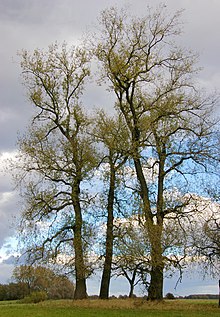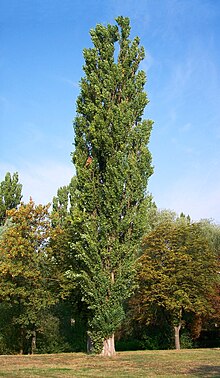Populus: Difference between revisions
m robot Adding: hsb:Topoł |
Added a note for use of poplars in decontamination of toxic waste sites. |
||
| Line 133: | Line 133: | ||
| doi =10.2307/533891 |
| doi =10.2307/533891 |
||
| author =Steiner, Roland}} </ref> |
| author =Steiner, Roland}} </ref> |
||
===Cleaning contaminated sites=== |
|||
Poplars may be used for [[Phytoremediation]]. Related research has taken place at the University of Washington. [http://uwnews.org/article.asp?articleid=37313][http://www.sciencedaily.com/releases/2008/01/080110144758.htm] |
|||
== References == |
== References == |
||
Revision as of 11:38, 15 March 2009
| Populus | |
|---|---|

| |
| Foliage of Populus tremula | |
| Scientific classification | |
| Kingdom: | |
| Division: | |
| Class: | |
| Order: | |
| Family: | |
| Genus: | Populus |
Populus is a genus of between 25–35 species of deciduous flowering plants in the family Salicaceae, native to most of the Northern Hemisphere. English names variously applied to different species include poplar, aspen, and cottonwood.
The genus has a large genetic diversity, and can grow from anywhere between 15–50 m tall, with trunks of up to 2.5 m diameter.

The bark on young trees is smooth, white to greenish or dark grey, often with conspicuous lenticels; on old trees it remains smooth in some species, but becomes rough and deeply fissured in others. The shoots are stout, with (unlike in the related willows) the terminal bud present. The leaves are spirally arranged, and vary in shape from triangular to circular or (rarely) lobed, and with a long petiole; in species in the sections Populus and Aegiros, the petioles are laterally flattened, so that breezes easily cause the leaves to wobble back and forth, giving the whole tree a "twinkling" appearance in a breeze. Leaf size is very variable even on a single tree, typically with small leaves on side shoots, and very large leaves on strong-growing lead shoots. The leaves often turn bright gold to yellow before they fall during autumn.[1][2]
The flowers are mostly dioecious (rarely monoecious) and appear in early spring before the leaves. They are borne in long, drooping, sessile or pedunculate catkins produced from buds formed in the axils of the leaves of the previous year. The flowers are each seated in a cup-shaped disk which is borne on the base of a scale which is itself attached to the rachis of the catkin. The scales are obovate, lobed and fringed, membranous, hairy or smooth, usually caducous. The male flowers are without calyx or corolla, and comprise a group of 4–60 stamens inserted on a disk; filaments short, pale yellow; anthers oblong, purple or red, introrse, two-celled; cells opening longitudinally. The female flower also has no calyx or corolla, and comprises a single-celled ovary seated in a cup-shaped disk. The style is short, with 2–4 stigmas, variously lobed, and numerous ovules. Pollination is by wind, with the female catkins lengthening considerably between pollination and maturity. The fruit is a two to four-valved capsule, green to reddish-brown, mature in mid summer, containing numerous minute light brown seeds surrounded by tufts of long, soft, white hairs which aid wind dispersal.[1][3]
Poplars of the cottonwood section are often wetlands or riparian trees. The aspens are among the most important boreal broadleaf trees.[1]
Poplars and aspens are important food plants for the larvae of a large number of Lepidoptera species - see List of Lepidoptera that feed on poplars.
Classification

The genus Populus has traditionally been divided into six sections on the basis of leaf and flower characters;[2][4] this classification is followed below. Recent genetic studies have largely supported this, though showing that the relationships are somewhat more complex, with some reticulate evolution due to past hybridisation and introgression events between the groups; some species (noted below) had differing relationships indicated by their nuclear DNA (paternally inherited) and chloroplast DNA sequences (maternally inherited), a clear indication of likely hybrid origin.[5] Hybridisation continues to be common in the genus, with several hybrids between species in different sections known.[1]

- Populus section Aegiros[6] - black poplars or cottonwoods. North America, Europe, western Asia; temperate
- Populus deltoides - Eastern Cottonwood. Eastern North America.
- Populus fremontii - Fremont Cottonwood. Western North America.
- Populus nigra - Black Poplar. Europe. Placed here by nuclear DNA; cpDNA places in sect. Populus.
- Populus × canadensis (P. nigra × P. deltoides) - Hybrid Black Poplar
- Populus section Populus - aspens and White Poplar. Circumpolar subarctic and cool temperate, and mountains farther south (White Poplar warm temperate)
- Populus tremula - Common Aspen, Trembling Aspen or Eurasian Aspen. Europe, northern Asia. This is the type species of the genus.
- Populus adenopoda - Chinese Aspen. Eastern Asia.
- Populus alba - White Poplar. Southern Europe to central Asia.
- Populus × canescens (P. alba × P. tremula) - Grey Poplar
- Populus grandidentata - Bigtooth Aspen. Eastern North America.
- Populus sieboldii - Japanese Aspen. Eastern Asia.
- Populus tremuloides - Quaking Aspen or Trembling Aspen. North America.

- Populus section Tacamahaca - balsam poplars. North America, Asia; cool temperate
- Populus angustifolia - Willow-leaved Poplar or Narrowleaf Cottonwood. Central North America.
- Populus balsamifera - Ontario Balsam Poplar. Northern North America.
- Populus laurifolia - Laurel-leaf Poplar. Central Asia.
- Populus maximowiczii - Maximowicz' Poplar. Northeast Asia.
- Populus simonii - Simon's Poplar. Northeast Asia.
- Populus szechuanica Northeast Asia. Placed here by nuclear DNA; cpDNA places in sect. Aegiros.
- Populus trichocarpa - Western Balsam Poplar or Black Cottonwood. Western North America.
- Populus tristis - Northeast Asia. Placed here by nuclear DNA; cpDNA places in sect. Aegiros.
- Populus section Leucoides - necklace poplars or bigleaf poplars. Eastern North America, eastern Asia; warm temperate
- Populus heterophylla - Swamp Cottonwood. Southeastern North America.
- Populus lasiocarpa - Chinese Necklace Poplar. Eastern Asia.
- Populus wilsonii - Wilson's Poplar. Eastern Asia.
- Populus section Turanga - subtropical poplars. Southwest Asia, east Africa; subtropical to tropical
- Populus euphratica - Euphrates Poplar. Southwest Asia.
- Populus ilicifolia - Tana River Poplar. East Africa.
- Populus section Abaso - Mexican poplars. Mexico; subtropical to tropical
- Populus guzmanantlensis Mexico.
- Populus mexicana - Mexico Poplar. Mexico.
In the September 2006 issue of Science, it was announced that Populus trichocarpa was the first tree to have its full DNA code sequenced.[7]
Cultivation

Many poplars are grown as ornamental trees, with numerous cultivars used. They have the advantage of growing very big, very fast. Almost all poplars take root readily from cuttings or where broken branches lie on the ground.
Trees with fastigiate (erect, columnar) branching are particularly popular, and are widely grown across Europe and southwest Asia. However, like willows, poplars have very vigorous and invasive root systems stretching up to 40 m from the trees; planting close to houses or ceramic water pipes may result in damaged foundations and cracked walls and pipes due to their search for moisture.
Uses
Manufacturing
- In many areas fast-growing hybrid poplars are grown on plantations for pulpwood
- It is also sold as inexpensive hardwood timber, used for pallets and cheap plywood; more specialised uses include matches and the boxes in which camembert cheese is sold.
- Poplar wood is also widely used in the snowboard industry for the snowboard "core", because it has exceptional flexibility, and is sometimes used in the bodies of electric guitars and drums.
- Poplar wood, particularly when seasoned, makes a good hearth for a bow drill.
- Due to its high tannic acid content, the bark has been used in Europe for tanning leather.[3]
- It was also picked as the material for the bones of "Buster", the crash test dummy used in the TV show MythBusters, after some experiments revealed that it fractures under approximately the same loads as human bone.
Energy
There is interest in using poplar as an energy crop for biomass or biofuel, in energy forestry systems, particularly in light of its high energy in-energy out ratio, large carbon mitigation potential and fast growth.
In the United Kingdom poplar (as with fellow energy crop willow) is typically grown for two to five years (with single or multiple stems), then harvested and burned - the yield of some varieties can be as high as 12 oven dry tonnes every year[9]
Art
Poplar was the most common wood used in Italy for panel paintings; the Mona Lisa and indeed most famous early renaissance Italian paintings are on poplar. The wood is generally white, often with a slightly yellowish cast.
Some stringed instruments are made with one-piece poplar backs; violas made in this fashion are said to have a particularly resonant tone.
Religion
Jesus' Cross
- A folk tradition noted among Michigan miners in the early 20th century asserted that poplar wood was used to make the cross upon which Jesus Christ was crucified.[10]
Cleaning contaminated sites
Poplars may be used for Phytoremediation. Related research has taken place at the University of Washington. [1][2]
References
- ^ a b c d Meikle, R. D. (1984). Willows and Poplars of Great Britain and Ireland. BSBI Handbook No. 4. ISBN 0-901158-07-0.
- ^ a b Rushforth, K. (1999). Trees of Britain and Europe. Collins ISBN 0-00-220013-9.
- ^ a b Keeler, H. L. (1900). Our Native Trees and How to Identify Them. New York: Charles Scriber's Sons. pp. 410–412.
- ^ Eckenwalder, J. E. (1977). North American cottonwoods (Populus, Salicaceae) of sections Abaso and Aigeiros. J. Arnold Arbor. 58: 193-208.
- ^ Hamzeh, M., & Dayanandan, S. (2004). Phylogeny of Populus (Salicaceae) based on nucleotide sequences of chloroplast TRNT-TRNF region and nuclear rDNA. Amer. J. Bot. 91: 1398-1408. Available online
- ^ Note: the spelling is disputed; some sources use Aegiros, others use Aigeiros
- ^ Joint Genome Institute: Populus trichocarpa
- ^ Poplar cultivation in Europe
- ^ Aylott, Matthew J. (2008). "Yield and spatial supply of bioenergy poplar and willow short-rotation coppice in the UK" (PDF). New Phytologist. 178 (2): 358–370. doi:10.1111/j.1469-8137.2008.02396.x. Retrieved 2008-10-22.
- ^ Steiner, Roland (1900). "Why the Poplar Stirs. Superstition of Miners in Michigan (in Notes and Queries)" (PDF). The Journal of American Folklore. 13 (50): 226. doi:10.2307/533891. Retrieved 2008-01-31.
